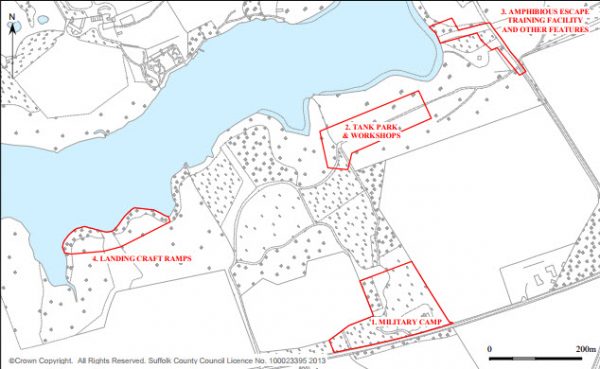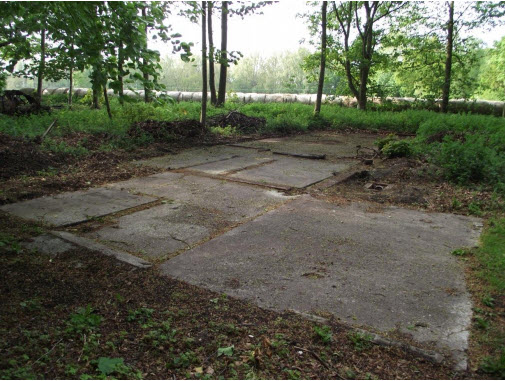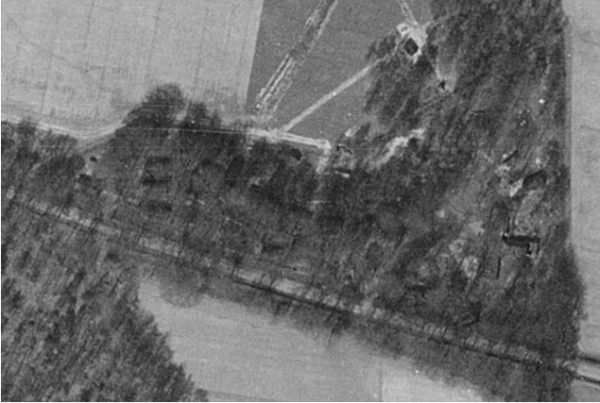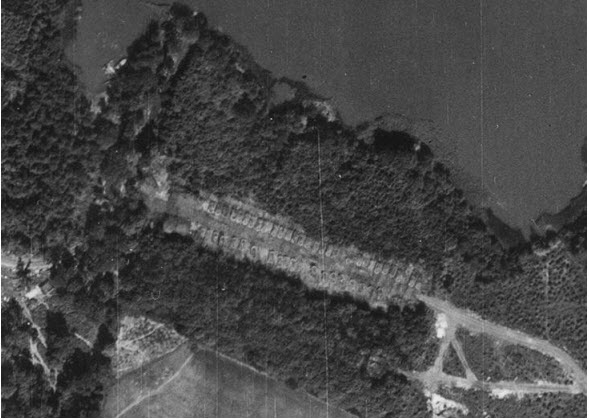Fritton Lake and the surrounding land was used by the 79th Armoured Division as a training and experimental site from 1943 through to 1947. It was used to secretly develop techniques and to instruct tank crews in the operation of amphibious tanks, known as Duplex Drive or DD Tanks, primarily for use in the allied invasion of France during World War 2.
by Stuart Burgess
It originally consisted of an accommodation area, workshop and maintenance buildings, dummy landing craft slipways, specific training structures, a large tank park and numerous tracks and roadways linking the various components.
Due to the secret nature of this establishment relatively little is known about its layout and operation. Following its decommissioning, the site was cleared and the majority of above ground structures demolished. Despite this, significant evidence is preserved at this site in the form of foundations, floor slabs, track ways, and areas of hard-standing as well as the structural remains of the landing craft slipways. There is also at least one extant building with significant portions of a second standing nearby. Many of these remains are relatively slight and are in danger of being destroyed or simply being lost. To mitigate against this and as an aid to further the understanding of this site, a survey of all the known extant remains was carried out. The main the aim of the survey was to produce a plan of the training establishment and to undertake a basic descriptive record of the remains.

The area around Fritton Lake, situated in the Suffolk parish of Somerleyton, Ashby and Herringfleet (formerly three separate parishes, now a single entity), was used by the 79th Armoured Division of the British Army, during the 1940’s, for the development of amphibious tanks and as a training establishment for crews to familiarize themselves with their use. The main drive behind the training program was the proposed D-Day landings, which comprised a significant part of the Allied invasion of Europe leading to the end of World War Two. The amphibious tanks were known as DD Tanks, which stood for ‘Duplex Drive’ and was a reference to the tank’s twin drive system needed to incorporate propellers for use when floating. The act of using the tank on water was known as ‘swimming’ and they were often confusingly referred to as ‘swimming tanks’.

The site was in use until 1947 after which it was dismantled and the site returned to the original owners. Part of what had been an area of accommodation for men based at the site, including at least two extant buildings, was leased to the Scouting Organisation for use as a Scout Camp. The remainder of the land was restored and replanted as cover for game birds or returned to forestry. The entire site then lay undisturbed and virtually forgotten until the early part of the 21st century when the then Country Park Manger of the Somerleyton Estate, Stuart Burgess, recognized that significant components of the camp survived within the woodland on the south side of the lake and undertook a program of personal research and investigation into the site’s history with the ultimate aim of bringing recognition to the site’s historical
significance and to further understanding of the important role it played in World War Two. Although numerous remains are present scattered across the area, no attempts to assess the extent of the site’s survival had been undertaken. In order to rectify this, funding was obtained from the European Interreg IV A Project to undertake a basic survey of the extant remains.
Valentine and Sherman Tanks were adapted to make them amphibious, so that they could “swim” to shore and provide close fire support to the first wave of troops landing on enemy beaches. These tanks were part of a series of tanks that had been modified to do something more than just fight in the regular way, and were collectively known as “funnies”. The Lake became a significant training facility in 1943 and went on to train in excess of 2000 men prior to D Day and a further 500 after D Day. The DD tanks and their crews proved themselves as key and effective weapons for the D Day Landings, and as such became versatile in subsequent European Operations associated with Estuary and River crossing.

The significance of the Freshwater Training Wing cannot be underestimated in relation to the development of the Duplex Drive Tanks. Its archaeology concerns the Military Camp and functional infrastructure associated with the provision of elementary training, tactical development, amphibious tank escape as well as post war experimentation and trials. The 60 acre site is well preserved, with surviving features such as a tank park, contemporary Landing Craft slipways, subterranean structures and the footings of a large number of huts, stores and other buildings connected with the workshop and maintenance facility.

Two regiments – the 15th/ 19th Hussars and the Staffordshire Yeomanry undertook training at Fritton in preparation for their role in crossing European rivers with the DDs. As it transpires only the Staffordshire Regiment eventually undertook River Crossing Training at a special wing at Burton upon Stather, before undertaking European Operations with their DD tanks. During these operations it became evident that the heavy Sherman DDs encountered difficulties exiting the soft silty riverbanks, and to this end Fritton – as well as Burton upon Stather – assumed a secondary role – that of overcoming river obstacles. Additionally at this time, the 79th Armoured Division were being replaced by the Assault Training and Development Centre (ATDC). Research and trails continued at Fritton for a further 18 months under ATDC, before they were replaced by SADE – Specialised Armour Development Establishment.

Training continued at Fritton under SADE until 1947, where upon swimming tanks were becoming larger and more impractical to be launched at sea. A facility continued at Gosport for a number of years, and by 1951 that too was eventually closed. Infrastructure at Fritton was removed by 1950 and the woods and lake returned to the Estate. Part of the military camp was leased out to the Scouting Organisation, and the remainder of the land was replanted as cover for game birds and forestry.
Thus Duplex Drive Tank Development came to an end. Its role on D Day was a unique and significant. As a weapon hurriedly devised and tested during WWII it proved its effectiveness as a dual purpose vehicle. Every credit should go to the men who developed, trained and ultimately operated these tanks, many of whom were present at Fritton Lake from 1943-1947.

Photo by Jo Segers





